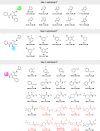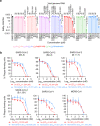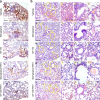A new generation Mpro inhibitor with potent activity against SARS-CoV-2 Omicron variants
- PMID: 36928316
- PMCID: PMC10018608
- DOI: 10.1038/s41392-023-01392-w
A new generation Mpro inhibitor with potent activity against SARS-CoV-2 Omicron variants
Abstract
Emerging SARS-CoV-2 variants, particularly the Omicron variant and its sublineages, continually threaten the global public health. Small molecule antivirals are an effective treatment strategy to fight against the virus. However, the first-generation antivirals either show limited clinical efficacy and/or have some defects in pharmacokinetic (PK) properties. Moreover, with increased use of these drugs across the globe, they face great pressure of drug resistance. We herein present the discovery and characterization of a new generation antiviral drug candidate (SY110), which is a potent and selective inhibitor of SARS-CoV-2 main protease (Mpro). This compound displayed potent in vitro antiviral activity against not only the predominant SARS-CoV-2 Omicron sublineage BA.5, but also other highly pathogenic human coronaviruses including SARS-CoV-1 and MERS-CoV. In the Omicron-infected K18-hACE2 mouse model, oral treatment with SY110 significantly lowered the viral burdens in lung and alleviated the virus-induced pathology. Importantly, SY110 possesses favorable PK properties with high oral drug exposure and oral bioavailability, and also an outstanding safety profile. Furthermore, SY110 exhibited sensitivity to several drug-resistance Mpro mutations. Collectively, this investigation provides a promising new drug candidate against Omicron and other variants of SARS-CoV-2.
© 2023. The Author(s).
Conflict of interest statement
All authors declared no competing interests. S.Y. is the member of editorial board, he has not been involved in the process of the manuscript handling.
Figures








Similar articles
-
Olgotrelvir, a dual inhibitor of SARS-CoV-2 Mpro and cathepsin L, as a standalone antiviral oral intervention candidate for COVID-19.Med. 2024 Jan 12;5(1):42-61.e23. doi: 10.1016/j.medj.2023.12.004. Epub 2024 Jan 4. Med. 2024. PMID: 38181791
-
Potent antiviral activity of simnotrelvir against key epidemic SARS-CoV-2 variants with a high resistance barrier.Antimicrob Agents Chemother. 2025 Apr 2;69(4):e0155624. doi: 10.1128/aac.01556-24. Epub 2025 Mar 10. Antimicrob Agents Chemother. 2025. PMID: 40062859 Free PMC article.
-
Postinfection treatment with a protease inhibitor increases survival of mice with a fatal SARS-CoV-2 infection.Proc Natl Acad Sci U S A. 2021 Jul 20;118(29):e2101555118. doi: 10.1073/pnas.2101555118. Proc Natl Acad Sci U S A. 2021. PMID: 34210738 Free PMC article.
-
SARS-CoV-2 Mpro: A Potential Target for Peptidomimetics and Small-Molecule Inhibitors.Biomolecules. 2021 Apr 19;11(4):607. doi: 10.3390/biom11040607. Biomolecules. 2021. PMID: 33921886 Free PMC article. Review.
-
Current status of antivirals and druggable targets of SARS CoV-2 and other human pathogenic coronaviruses.Drug Resist Updat. 2020 Dec;53:100721. doi: 10.1016/j.drup.2020.100721. Epub 2020 Aug 26. Drug Resist Updat. 2020. PMID: 33132205 Free PMC article. Review.
Cited by
-
Inhibitors of SARS-CoV-2 Main Protease (Mpro) as Anti-Coronavirus Agents.Biomolecules. 2024 Jul 4;14(7):797. doi: 10.3390/biom14070797. Biomolecules. 2024. PMID: 39062511 Free PMC article. Review.
-
Identification of SARS-CoV-2 Main Protease Inhibitors Using Chemical Similarity Analysis Combined with Machine Learning.Pharmaceuticals (Basel). 2024 Feb 12;17(2):240. doi: 10.3390/ph17020240. Pharmaceuticals (Basel). 2024. PMID: 38399455 Free PMC article.
-
Molecular Recognition of SARS-CoV-2 Mpro Inhibitors: Insights from Cheminformatics and Quantum Chemistry.Molecules. 2025 May 15;30(10):2174. doi: 10.3390/molecules30102174. Molecules. 2025. PMID: 40430346 Free PMC article.
-
Development of potent and effective SARS-CoV-2 main protease inhibitors based on maleimide analogs for the potential treatment of COVID-19.J Enzyme Inhib Med Chem. 2024 Dec;39(1):2290910. doi: 10.1080/14756366.2023.2290910. Epub 2023 Dec 13. J Enzyme Inhib Med Chem. 2024. PMID: 38093611 Free PMC article.
-
Viral sepsis: diagnosis, clinical features, pathogenesis, and clinical considerations.Mil Med Res. 2024 Dec 16;11(1):78. doi: 10.1186/s40779-024-00581-0. Mil Med Res. 2024. PMID: 39676169 Free PMC article. Review.
References
Publication types
MeSH terms
Substances
Supplementary concepts
LinkOut - more resources
Full Text Sources
Medical
Molecular Biology Databases
Miscellaneous

